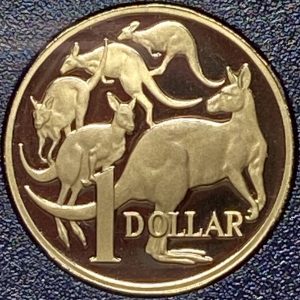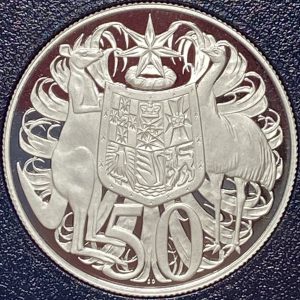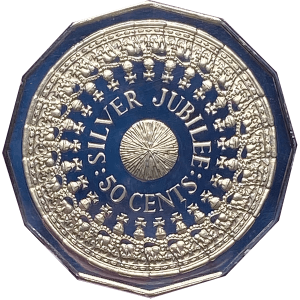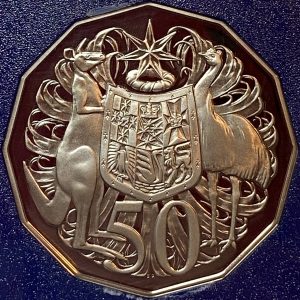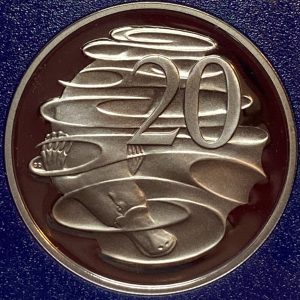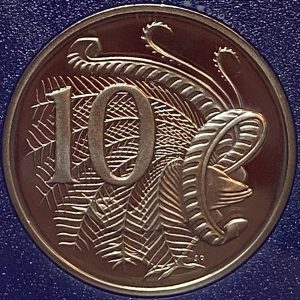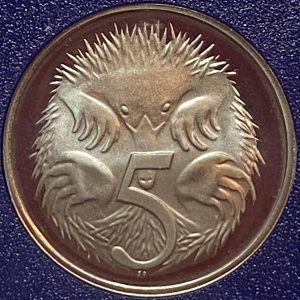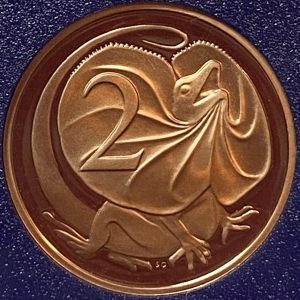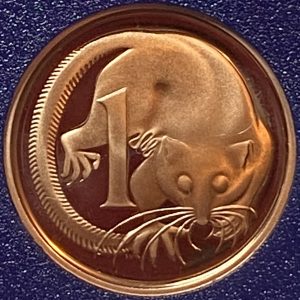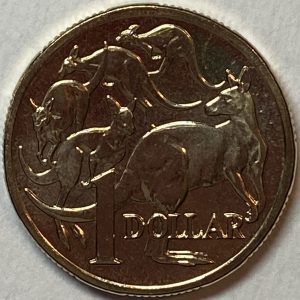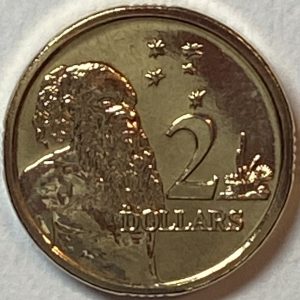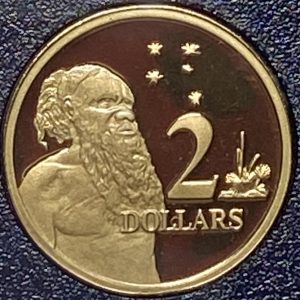
Australian Decimal coins
proof coins
Proofs are coins specially struck by the mint on prepared polished or matt surface panchets (blanks). The dies used for the striking are also polished, to produce coins with brilliant surfaces and perfect detail.
uncirculated coins
Uncirculated specimens should show no sign of wear or scratches, or any evidence of circulation. They may show slight imperfections from production. The design and lettering are sharp and clear.
Decimal coins
one cent
The one cent coin was first introduced with decimal currency on 14 February 1966. The original reverse design of a feather tailed glider has not been changed since the introduction.
One cent coins were produced by the Royal Australian Mint, the Royal Mint Melbourne branch, the Royal Mint Perth branch, and the Royal Mint, Llantrisant. Production of 1966-dated one cent coins commenced at the Royal Mint Melbourne branch in 1964.
The cessation of issue of one and two cent coins was announced by the Treasurer in his Budget Speech of 21 August 1990. The decision was based on the loss of real purchasing power through inflation and the cost of minting these coins. The accompanying Press Release noted that
“..1c and 2c coins will continue to be legal tender: they can still be used to purchase goods and can be deposited with financial institutions in the normal manner.”
Both coins were withdrawn from circulation commencing in February 1992.
Nominal Specifications
Composition: 97% Copper – 2.5% Zinc – 0.5% Tin
Shape: Circular
Edge: Plain
Mass: 2.60 grams
Diameter: 17.65 millimetres
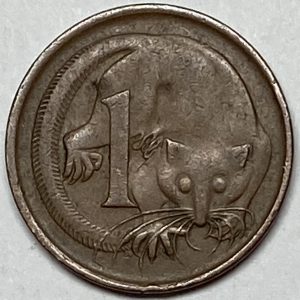
1966 Australia 1 cent
Pre-decimal Australian & UK coins, banknotes and world coins Circulated. The Australian one cent piece features the portrait of Queen Elizabeth II facing right wearing
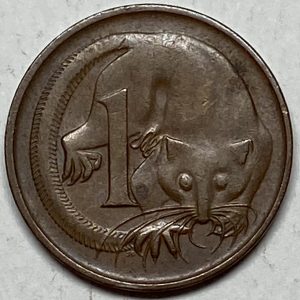
1970 Australia 1 cent
Pre-decimal Australian & UK coins, banknotes and world coins Circulated. The Australian one cent piece features the portrait of Queen Elizabeth II facing right wearing
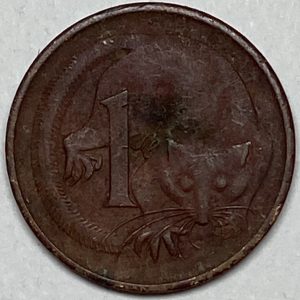
1973 Australia 1 cent
Pre-decimal Australian & UK coins, banknotes and world coins Circulated. The Australian one cent piece features the portrait of Queen Elizabeth II facing right wearing
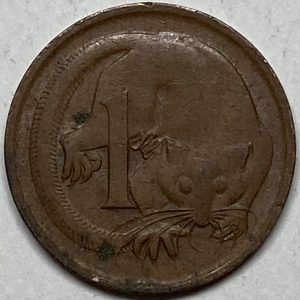
1974 Australia 1 cent
Pre-decimal Australian & UK coins, banknotes and world coins Circulated. The Australian one cent piece features the portrait of Queen Elizabeth II facing right wearing
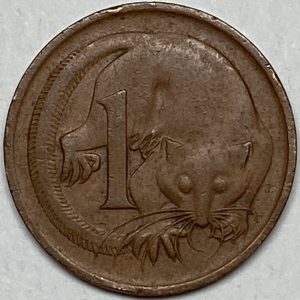
1975 Australia 1 cent
Pre-decimal Australian & UK coins, banknotes and world coins Circulated. The Australian one cent piece features the portrait of Queen Elizabeth II facing right wearing
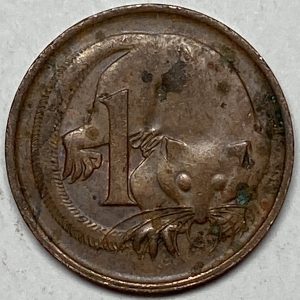
1976 Australia 1 cent
Pre-decimal Australian & UK coins, banknotes and world coins Circulated. The Australian one cent piece features the portrait of Queen Elizabeth II facing right wearing
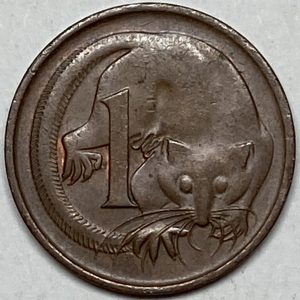
1980 Australia 1 cent
Pre-decimal Australian & UK coins, banknotes and world coins Circulated. The Australian one cent piece features the portrait of Queen Elizabeth II facing right wearing
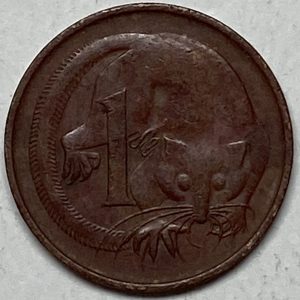
1981 Australia 1 cent
Pre-decimal Australian & UK coins, banknotes and world coins Circulated. The Australian one cent piece features the portrait of Queen Elizabeth II facing right wearing
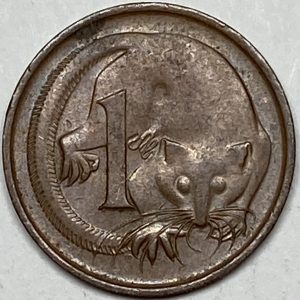
1982 Australia 1 cent
Pre-decimal Australian & UK coins, banknotes and world coins Circulated. The Australian one cent piece features the portrait of Queen Elizabeth II facing right wearing
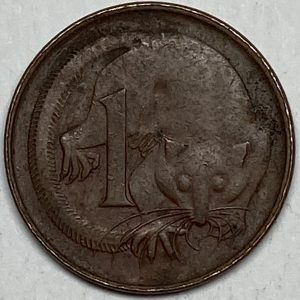
1983 Australia 1 cent
Pre-decimal Australian & UK coins, banknotes and world coins Circulated. The Australian one cent piece features the portrait of Queen Elizabeth II facing right wearing
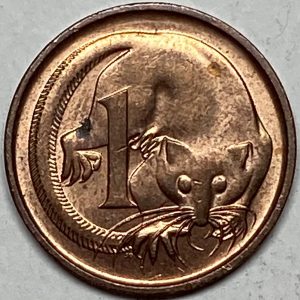
1987 Australia 1 cent
Pre-decimal Australian & UK coins, banknotes and world coins Circulated. The Australian one cent piece features the portrait of Queen Elizabeth II facing right wearing
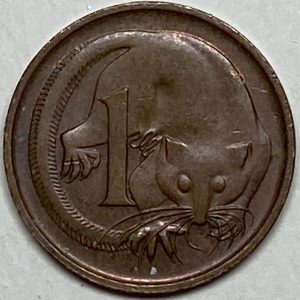
1988 Australia 1 cent
Pre-decimal Australian & UK coins, banknotes and world coins Circulated. The Australian one cent piece features the portrait of Queen Elizabeth II facing right wearing
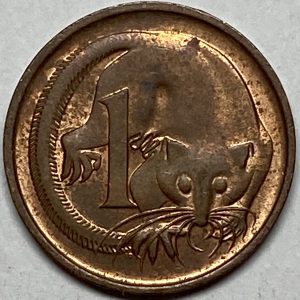
1989 Australia 1 cent
Pre-decimal Australian & UK coins, banknotes and world coins Circulated. The Australian one cent piece features the portrait of Queen Elizabeth II facing right wearing
two cents
The two cent coin was first introduced with decimal currency on 14 February 1966. The original reverse design of the frill-necked lizard has not been changed since the introduction.
Two cent coins were produced by the Royal Australian Mint, the Royal Mint Melbourne branch, the Royal Mint Perth branch, and the Royal Mint, Llantrisant. The two cent coin was the last circulating coin for Australia struck outside the Royal Australian Mint.
The cessation of issue of one and two cent coins was announced by the Treasurer in his Budget Speech of 21 August 1990. The decision was based on the loss of real purchasing power through inflation and the cost of minting of these coins. The accompanying Press Release noted that
“…1c and 2c coins will continue to be legal tender: they can still be used to purchase goods and can be deposited with financial institutions in the normal manner.”
Both coins were withdrawn from circulation commencing in February 1992.
Nominal Specifications
Composition: 97% Copper – 2.5% Zinc – 0.5% Tin
Shape: Circular
Edge: Plain
Mass: 5.20 grams
Diameter: 21.59 millimetres
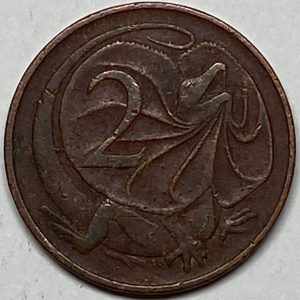
1966 Australia 2 cents
Pre-decimal Australian & UK coins, banknotes and world coins Circulated. The Australian two cent piece features the 2nd portrait of Queen Elizabeth II facing right
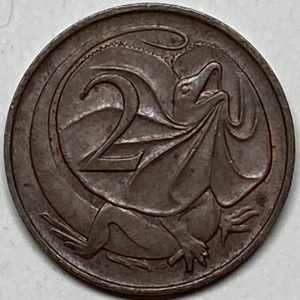
1967 Australia 2 cents
Pre-decimal Australian & UK coins, banknotes and world coins Circulated. The Australian two cent piece features the 2nd portrait of Queen Elizabeth II facing right
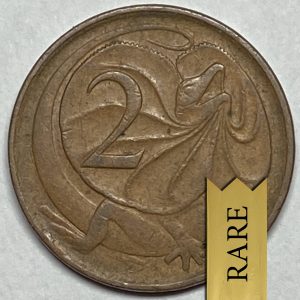
1967 Australia 2c ‘No SD’
Pre-decimal Australian & UK coins, banknotes and world coins Grading and value 1967 and 1968 No SD 2c in nice red uncirculated condition graded by
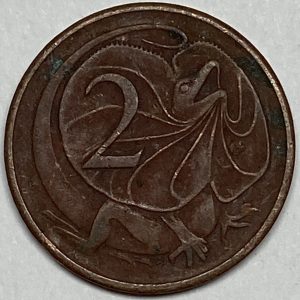
1970 Australia 2 cents
Pre-decimal Australian & UK coins, banknotes and world coins Circulated. The Australian two cent piece features the 2nd portrait of Queen Elizabeth II facing right
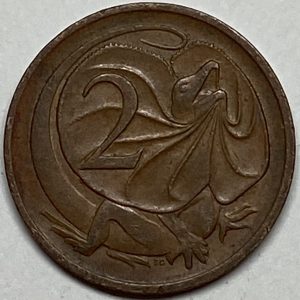
1971 Australia 2 cents
Pre-decimal Australian & UK coins, banknotes and world coins Circulated. The Australian two cent piece features the 2nd portrait of Queen Elizabeth II facing right
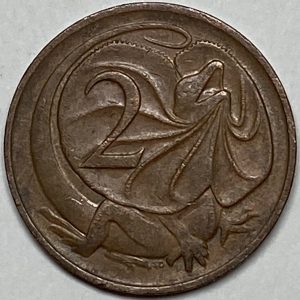
1974 Australia 2 cents
Pre-decimal Australian & UK coins, banknotes and world coins Circulated. The Australian two cent piece features the 2nd portrait of Queen Elizabeth II facing right
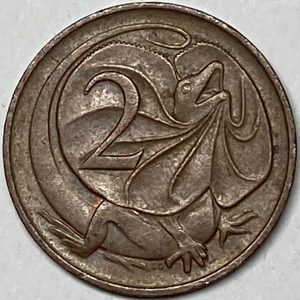
1975 Australia 2 cents
Pre-decimal Australian & UK coins, banknotes and world coins Circulated. The Australian two cent piece features the 2nd portrait of Queen Elizabeth II facing right
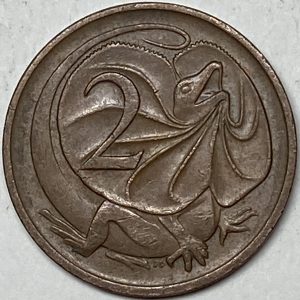
1977 Australia 2 cents
Pre-decimal Australian & UK coins, banknotes and world coins Circulated. The Australian two cent piece features the 2nd portrait of Queen Elizabeth II facing right
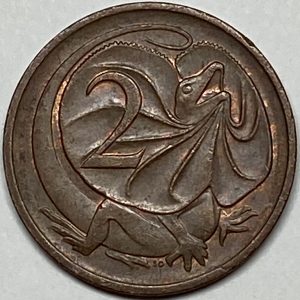
1978 Australia 2 cents
Pre-decimal Australian & UK coins, banknotes and world coins Circulated. The Australian two cent piece features the 2nd portrait of Queen Elizabeth II facing right
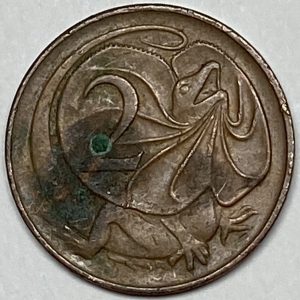
1979 Australia 2 cents
Pre-decimal Australian & UK coins, banknotes and world coins Circulated. The Australian two cent piece features the 2nd portrait of Queen Elizabeth II facing right
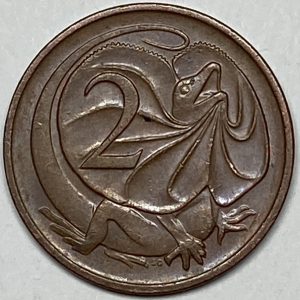
1981 Australia 2 cents
Pre-decimal Australian & UK coins, banknotes and world coins Circulated. The Australian two cent piece features the 2nd portrait of Queen Elizabeth II facing right
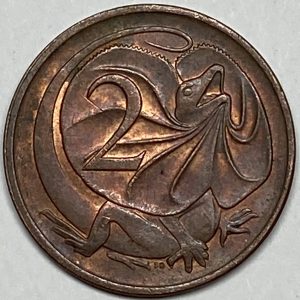
1983 Australia 2 cents
Pre-decimal Australian & UK coins, banknotes and world coins Circulated. The Australian two cent piece features the 2nd portrait of Queen Elizabeth II facing right
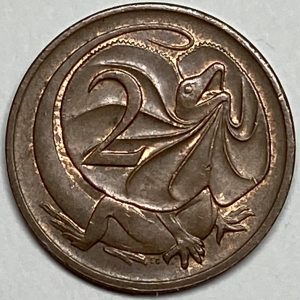
1984 Australia 2 cents
Pre-decimal Australian & UK coins, banknotes and world coins Circulated. The Australian two cent piece features the 2nd portrait of Queen Elizabeth II facing right
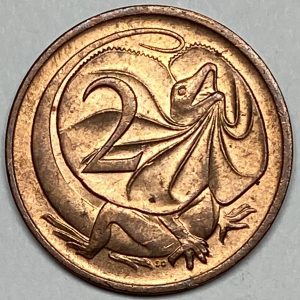
1985 Australia 2 cents
Pre-decimal Australian & UK coins, banknotes and world coins Circulated. The Australian two cent piece features the 2nd portrait of Queen Elizabeth II facing right
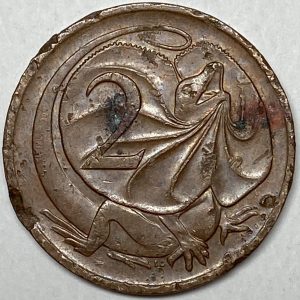
1989 Australia 2 cents
Pre-decimal Australian & UK coins, banknotes and world coins Circulated. The Australian two cent piece features the 2nd portrait of Queen Elizabeth II facing right
Five cents
The five cent coin was first introduced with decimal currency on 14 February 1966. The original reverse design of the echidna on standard circulating coins has not been changed since the introduction. The obverse design was altered in 2016 to mark the 50th anniversary of decimal currency, but the reverse design of the echidna has remained constant.
All of the first issue of five cent coins in 1966 were produced at the Royal Mint, London. Since the first production from London, five cent coins have been produced by the Royal Australian Mint, the Royal Mint, Llantrisant and the Royal Canadian Mint.
Nominal Specifications
Composition: 75% Copper – 25% Nickel
Shape: Circular
Edge: Milled
Mass: 2.83 grams
Diameter: 19.41 millimetres
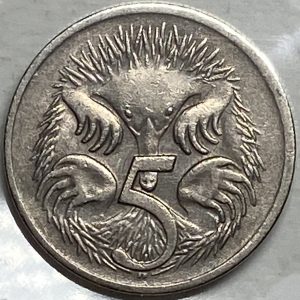
1966 Australia 5 cent
Pre-decimal Australian & UK coins, banknotes and world coins Circulated. The Australian five-cent piece features the portrait of Queen Elizabeth II facing right wearing the
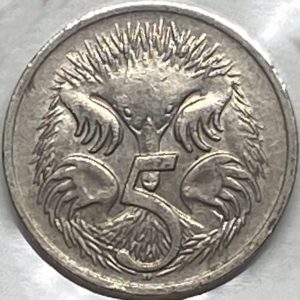
1968 Australia 5 cent
Pre-decimal Australian & UK coins, banknotes and world coins Circulated. The Australian five-cent piece features the portrait of Queen Elizabeth II facing right wearing the
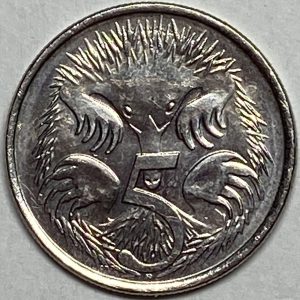
2016 Australia 5 cent 50th Ann. Decimal Currency
Pre-decimal Australian & UK coins, banknotes and world coins Circulated. The 2016 Australia Five Cent Commemorative issue for the 50th Anniversary of Decimal Currency features a
Ten cents
The ten cent coin was first introduced with decimal currency on 14 February 1966. The original reverse design of the lyrebird on standard circulating coins has not been changed since the introduction. The obverse design was altered in 2016 to mark the 50th anniversary of decimal currency, but the reverse design of the lyrebird has remained constant.
All of the first issue of ten cent coins in 1966 were produced at the Royal Mint, London. Since the first production from London, ten cent coins have been produced by the Royal Australian Mint and the Royal Mint, Llantrisant.
Nominal specifications
Composition: 75% Copper – 25% Nickel
Shape: Circular
Edge: Milled
Mass: 5.65 grams
Diameter: 23.60 millimetres
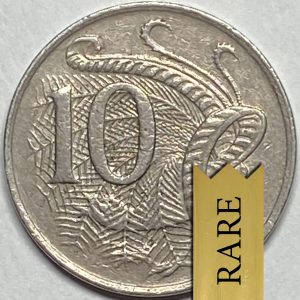
1985 Australia 10c
Pre-decimal Australian & UK coins, banknotes and world coins Circulated. The 1985 Australia 10c coin features the 3rd portrait of Queen Elizabeth II facing right
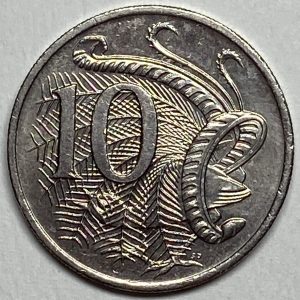
2016 Australia 10 cent 50th Ann. Decimal Currency
Pre-decimal Australian & UK coins, banknotes and world coins Circulated. The 2016 commemorative Australia Ten cent issue celebrates the 50th Anniversary of Decimal Currency. Featuring
Twenty cents
The twenty cent coin was first introduced with decimal currency on 14 February 1966. The original reverse design of a platypus remained unchanged until 1995. This denomination has since been used for commemorative designs.
All twenty cent coins in the first issue in 1966 were produced at the Royal Mint, London. The Royal Australian Mint did not commence twenty cent coin production until the next financial year. Quantities of twenty cents have also been struck by the Royal Mint, Llantrisant and the Royal Canadian Mint.
Nominal specifications
Composition: 75% Copper – 25% Nickel
Shape: Circular
Edge: Milled
Mass: 11.3 grams
Diameter: 28.65 millimetres

1966 Australia 20 cents
Pre-decimal Australian & UK coins, banknotes and world coins Circulated. The Australian twenty-cent piece features the portrait of Queen Elizabeth II facing right wearing the
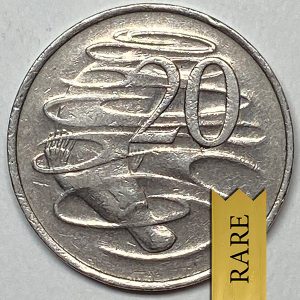
1981 Australia 20 cent ‘3 1/2 claws’
Pre-decimal Australian & UK coins, banknotes and world coins Circulated. In this particular year, industrial action at the Royal Australian Mint saw Australia once again
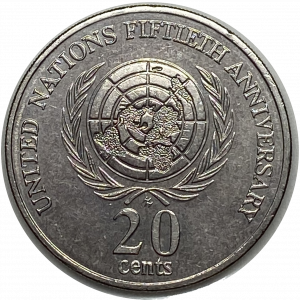
1995 Australia 20 cent 50th UN
Pre-decimal Australian & UK coins, banknotes and world coins Circulated. The 1995 Australia 20c Commemorative issue for the 50th Anniversary of the United Nations features the
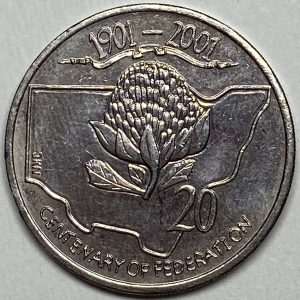
2001 Australia 20 cent NSW
Pre-decimal Australian & UK coins, banknotes and world coins Circulated. The 2001 commemorative Australia Twenty cent issue celebrates the Centenary of Federation of New South Wales.
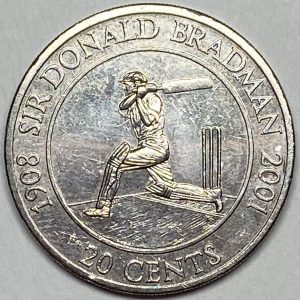
2001 Australia 20 cent Sir Donald Bradman
Pre-decimal Australian & UK coins, banknotes and world coins Circulated. The 2001 Australia 20c Commemorative issue of Sir Donald Bradman features the 4th portrait of
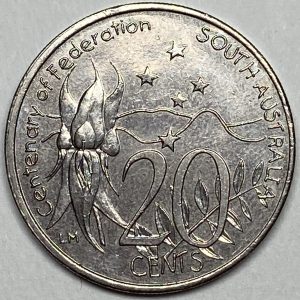
2001 Australia 20 cent Student design SA
Pre-decimal Australian & UK coins, banknotes and world coins Circulated. The 2001 Australia 20c Commemorative issue for the Centenary of Federation student design for South Australia
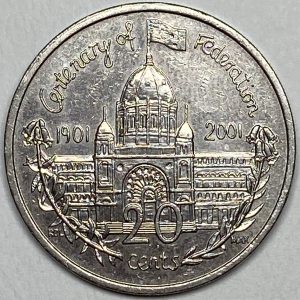
2001 Australia 20 cent VIC
Pre-decimal Australian & UK coins, banknotes and world coins Circulated. The 2001 commemorative Australia Twenty cent issue celebrates the Centenary of Federation of Victoria. Featuring
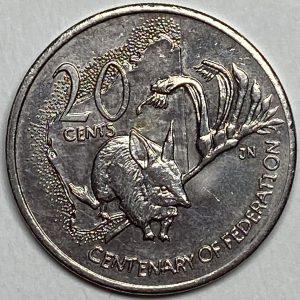
2001 Australia 20 cent WA
Pre-decimal Australian & UK coins, banknotes and world coins Circulated. The 2001 commemorative Australia Twenty cent issue celebrates the Centenary of Federation of Western Australia.
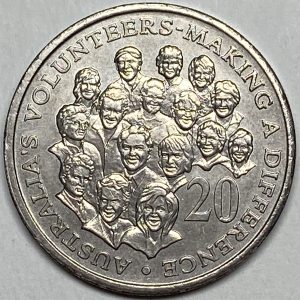
2003 Australia 20 cent Volunteers
Pre-decimal Australian & UK coins, banknotes and world coins Circulated. The 2003 commemorative Australia Twenty cent issue celebrates Australia’s Volunteers. Featuring the 4th portrait of
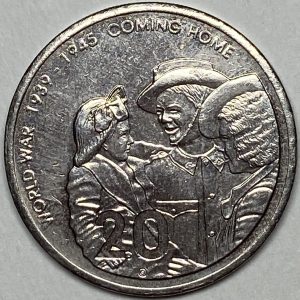
2005 Australia 20 cent End of WW2
Pre-decimal Australian & UK coins, banknotes and world coins Circulated. The 2005 commemorative Australia Twenty cent issue celebrates the 60th Anniversary of World War II
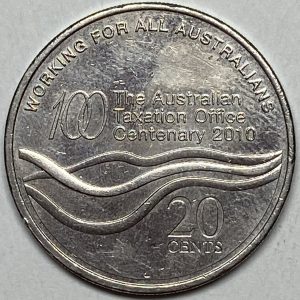
2010 Australia 20 cent ATO
Pre-decimal Australian & UK coins, banknotes and world coins Circulated. The 2010 commemorative Australia Twenty cent issue celebrates the 100th Anniversary of the Taxation Office.
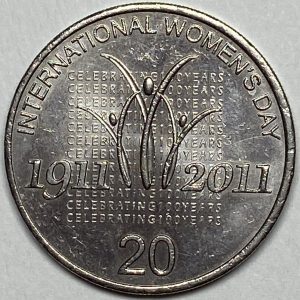
2011 Australia 20 cent International Women’s Day
Pre-decimal Australian & UK coins, banknotes and world coins Circulated. The 2011 commemorative Australia Twenty cent issue celebrate the 100th Anniversary of International Women’s Day.
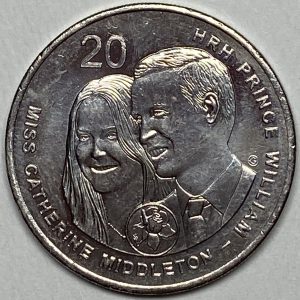
2011 Australia 20 cent Royal Wedding
Pre-decimal Australian & UK coins, banknotes and world coins Circulated. The 2011 commemorative Australia Twenty cent issue celebrates the Royal Wedding of Prince William and
fifty cents
The fifty cent coin was first introduced with decimal currency on 14 February 1966. The original design featured the Commonwealth Coat of Arms struck on a coin made from 80% silver. However as the silver price rose above the face value of the coin the Mint suspended striking of the coin in March 1968.
Although it was rumoured that the Mint had lost money striking the fifty cent, all the metal used in the manufacture of the 36.5 million coins produced was purchased before the price rises.
Apart from the uneconomic cost of continuing the issue of the silver fifty cent coins, increasing confusion arose regarding the similarity in sizes between the circular fifty cent and the twenty cent coin. The decision to reissue a fifty cent coin considered not only a change to materials but also different shapes to help solve the confusion with the twenty cents.
A new shape and alloy was reintroduced into circulation in September 1969.
This denomination has since been used for commemorative designs.
Nominal specifications
| 1966 | 1969 – present |
| Composition: 80% Silver – 20 % Copper | Composition: 75% Copper – 25% Nickel |
| Shape: Circular | Shape: Dodecagonal |
| Edge: Milled | Edge: Plain |
| Mass: 13.28 grams | Mass: 15.55 grams |
| Diameter: 31.65 millimetres | Diameter: 31.65 millimetres (across flats) |
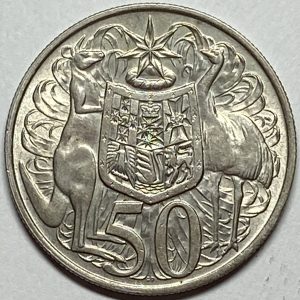
1966 Australia 50c
Pre-decimal Australian & UK coins, banknotes and world coins Circulated. The 1966 Australia 50c coin features the 2nd portrait of Queen Elizabeth II facing right wearing
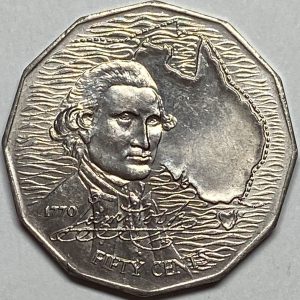
1970 Australia 50c Bicentenary Cook
Pre-decimal Australian & UK coins, banknotes and world coins Circulated. The 1970 Australia 50c 200th Anniversary of Cook’s Australian Voyage commemorative coin features the 2nd
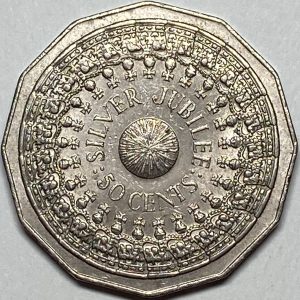
1977 Australia 50c Silver Jubilee
Pre-decimal Australian & UK coins, banknotes and world coins Circulated. The 1977 Australia 50c Commemorative issue for the 25th Anniversary of the Accession of Elizabeth
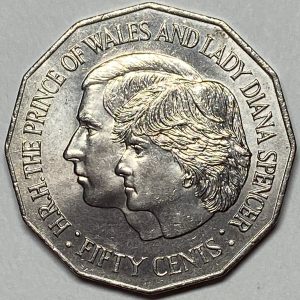
1981 Australia 50c Royal Wedding
Pre-decimal Australian & UK coins, banknotes and world coins Circulated. The 1981 Australia 50c Commemorative issue of the wedding of Prince Charles and Lady Diana
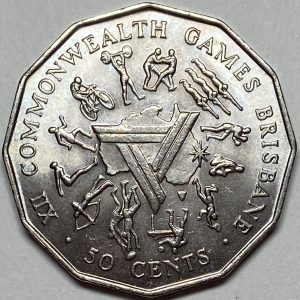
1982 Australia 50c XII Commonwealth Games
Pre-decimal Australian & UK coins, banknotes and world coins Circulated. The 1982 Australia 50c Commemorative issue of the XII Commonwealth Games in Brisbane features the 2nd portrait
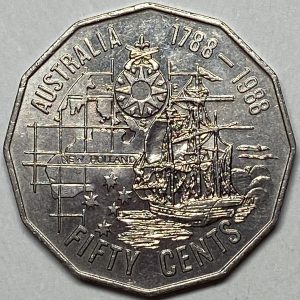
1988 Australia 50c Bicentenary
Pre-decimal Australian & UK coins, banknotes and world coins Circulated. The 1988 Australia 50c Commemorative issue of the 200th Anniversary First Fleet features the 3rd
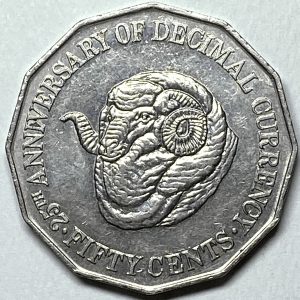
1991 Australia 50c 25th Anniversary
Pre-decimal Australian & UK coins, banknotes and world coins Circulated. The 1991 Australia 50c “Ram’s head” Commemorative issue of the 25th Anniversary of Decimal Currency
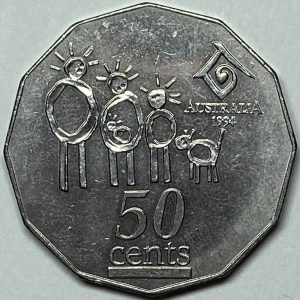
1994 Australia 50c Year of the family
Pre-decimal Australian & UK coins, banknotes and world coins Circulated. The 1994 Australia 50c Commemorative issue for International Year of the Family coin features the 3rd
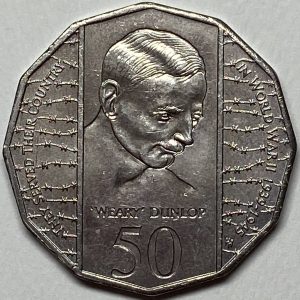
1995 Australia 50c End of WWII
Pre-decimal Australian & UK coins, banknotes and world coins Circulated. The 1995 Australia 50c Commemorative issue for 50th Anniversary of the end of World War II
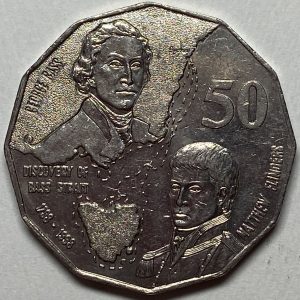
1998 Australia 50c Bass & Flinders
Pre-decimal Australian & UK coins, banknotes and world coins Circulated. The 1998 Australia 50c Commemorative issue for the 200th Anniversary of the Discovery of Bass
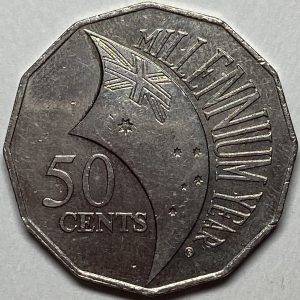
2000 Australia 50c Millenium
Pre-decimal Australian & UK coins, banknotes and world coins Circulated. The 2000 Australia 50c Commemorative issue of the Millennium Year features the 4th portrait of Queen
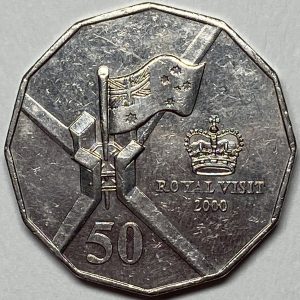
2000 Australia 50c Royal Visit
Pre-decimal Australian & UK coins, banknotes and world coins Circulated. The 2000 Australia 50c Commemorative issue of Royal Visit 2000 features the 5th Portrait of Queen
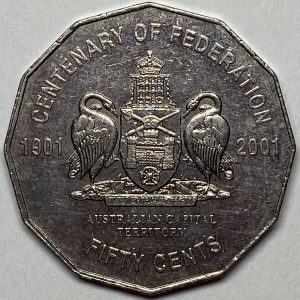
2001 Australia 50c ACT Coat of Arms
Pre-decimal Australian & UK coins, banknotes and world coins Circulated. The 2001 Australia 50c Commemorative issue with Australian Capital Territory ‘coat of arms’ celebrates 100th
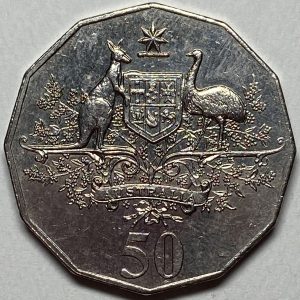
2001 Australia 50c Centenary of Federation
Pre-decimal Australian & UK coins, banknotes and world coins Circulated. The 2001 Australia 50c Commemorative issue celebrates the 100th Anniversary of Federation – Australia, featuring the
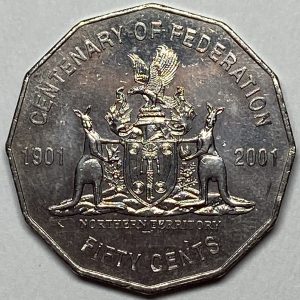
2001 Australia 50c NT Coat of Arms
Pre-decimal Australian & UK coins, banknotes and world coins Circulated. The 2001 Australia 50c Commemorative issue with Northern Territory ‘coat of arms’ celebrates 100th Anniversary
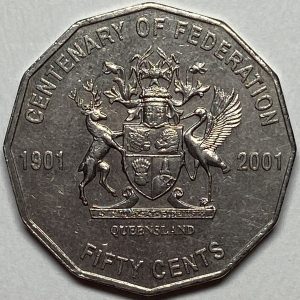
2001 Australia 50c QLD Coat of Arms
Pre-decimal Australian & UK coins, banknotes and world coins Circulated. The 2001 Australia 50c Commemorative issue with Queensland ‘coat of arms’ celebrates 100th Anniversary of
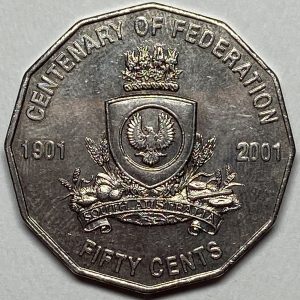
2001 Australia 50c SA Coat of Arms
Pre-decimal Australian & UK coins, banknotes and world coins Circulated. The 2001 Australia 50c Commemorative issue with South Australia ‘coat of arms’ celebrates 100th Anniversary
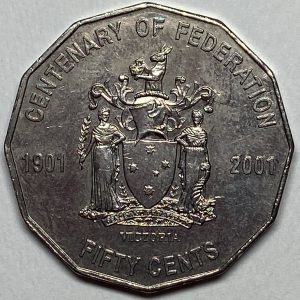
2001 Australia 50c VIC Coat of Arms
Pre-decimal Australian & UK coins, banknotes and world coins Circulated. The 2001 Australia 50c Commemorative issue with Victoria ‘coat of arms’ celebrates 100th Anniversary of
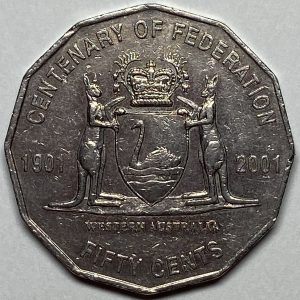
2001 Australia 50c WA Coat of Arms
Pre-decimal Australian & UK coins, banknotes and world coins Circulated. The 2001 Australia 50c Commemorative issue with Western Australia ‘coat of arms’ celebrates 100th Anniversary
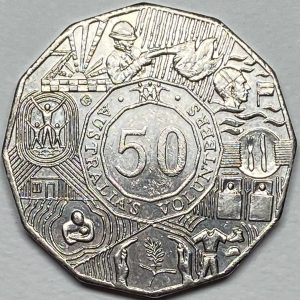
2003 Australia 50c Volunteers
Pre-decimal Australian & UK coins, banknotes and world coins Circulated. The 2003 commemorative Australia Fifty cent issue celebrates Australia’s Volunteers. Featuring the 4th portrait of
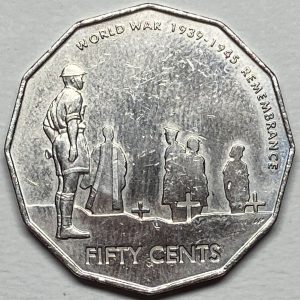
2005 Australia 50c Remembrance
Pre-decimal Australian & UK coins, banknotes and world coins Circulated. The 2005 commemorative Australia Fifty cent issue celebrates the 60th Anniversary of World War II
One dollar
The one dollar coin was first introduced on 14 May 1984. Planning for a one dollar coin commenced as early as the mid-1970s. It was recognised that Australia needed a higher value coin which could be practically used in coin operated machines and to replace the one dollar note which had a short service life through high use.
Mr Stuart Devlin was commissioned to design the reverse of the new coin. The five kangaroos design was chosen from submissions received from the designer.
This denomination has since been used for commemorative designs.
Nominal specifications
Composition: 92% Copper – 6% Aluminium – 2% Nickel
Shape: Circular
Edge: Interrupted Milled
Mass: 9.00 grams
Diameter: 25.00 millimetres
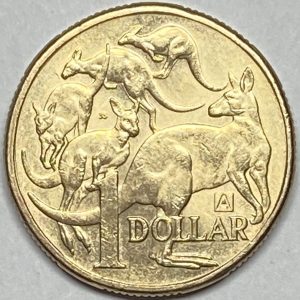
2019 Australia $1 35th ‘A’
Pre-decimal Australian & UK coins, banknotes and world coins Circulated. To celebrate the 35th anniversary of the Australian one dollar coin, the Royal Australian Mint
Two dollars
The two dollar coin was first introduced on 20 June 1988. Planning for a two dollar coin commenced around the same time as that for the one dollar coin. Like the one dollar, the two dollar coin replaced the note of the same denomination which had a short service life through high use.
The image on the Australian two dollar coin represents an archetype of an Aboriginal tribal elder, designed by Horst Hahne.
Numerous designers were invited to contribute designs for the two dollar coin based on a brief to include a representation of the head and shoulders of an Aboriginal Australian, the Southern Cross and Australian flora.
The selected design was inspired by an artwork by Ainslie Roberts and modified in line with coin production requirements. Roberts used some features of Gwoya Tjungurrayi, otherwise known as One Pound Jimmy, as inspiration when creating a portrait depicting a traditional Aboriginal tribal elder. The rest of the features were derived from Roberts’ imagination and visual memory developed after drawing thousands of images of Indigenous people.
The size of the two dollar was determined after consideration of the needs of the visually impaired community, security considerations, a desire to avoid shaped coins, practical limitations to the diameter and thickness of coins, and to allow for future expansion of Australia’s circulating coin array. When introduced, it was necessary to accommodate this new coin with seven existing denominations.
This denomination has since been used for commemorative designs.
Nominal Specifications
Composition: 92% Copper – 6% Aluminium – 2% Nickel
Shape: Circular
Edge: Interrupted Milled
Mass: 6.60 grams
Diameter: 20.50 millimetres
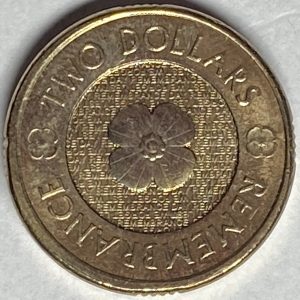
2012 Australia $2 Remembrance Day
Pre-decimal Australian & UK coins, banknotes and world coins Circulated. The 2012 Australia $2 Remembrance Day coin features the 4th portrait of Queen Elizabeth II
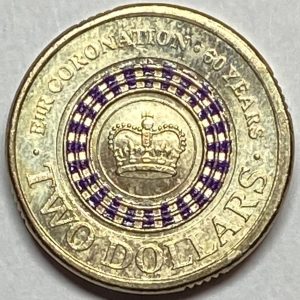
2013 Australia $2 Coronation Coin
Pre-decimal Australian & UK coins, banknotes and world coins Commemorating the 60th anniversary of the Coronation of Her Majesty Queen Elizabeth II with concentric purple stripes
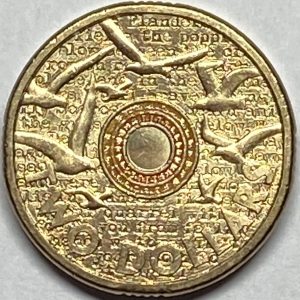
2015 Australia $2 Remembrance
Pre-decimal Australian & UK coins, banknotes and world coins Circulated. Lettering: In Flanders fields the poppy blow Between the are row on row, That mark
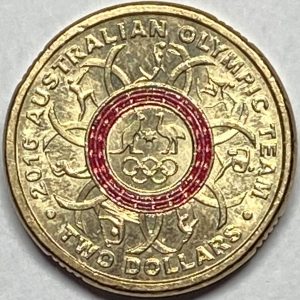
2016 Australia $2 Olympic Team
Pre-decimal Australian & UK coins, banknotes and world coins Circulated. The 2016 Australia $2 Olympic team commemorative issue features the 4th portrait of Queen Elizabeth
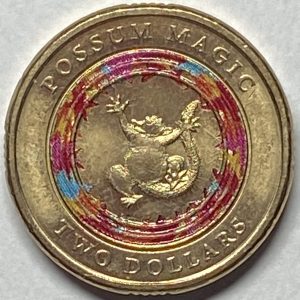
2017 Australia $2 Possum Magic
Pre-decimal Australian & UK coins, banknotes and world coins Circulated. The 2017 Australia $2 Possum Magic Commemorative issue coin features the 4th portrait of Queen
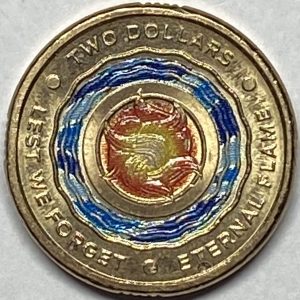
2018 Australia $2 Lest We Forget
Pre-decimal Australian & UK coins, banknotes and world coins Circulated. The 2018 Australia $2 Commemorative issue ‘Lest We Forget – Eternal Flame’ coin features the 4th
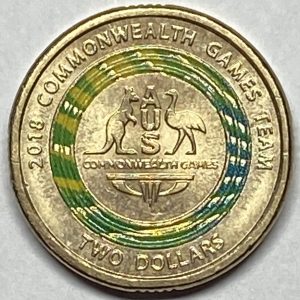
2018 Australia $2 XXI Comm Games
Pre-decimal Australian & UK coins, banknotes and world coins Circulated. The 2018 Australia $2 XXI Commonwealth Games commemorative issue features the 4th portrait of Queen Elizabeth
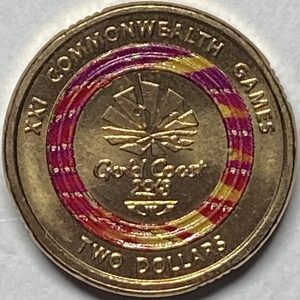
2018 Australia $2 XXI Comm Games Emblem
Pre-decimal Australian & UK coins, banknotes and world coins Circulated. The 2018 $2 XXI Commonwealth Games Emblem Commemorative issue features the 4th portrait of Queen
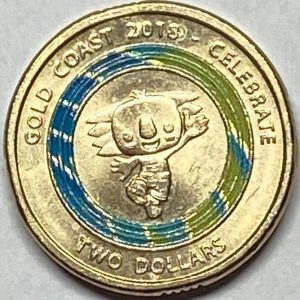
2018 Australia $2 XXI Comm Games Gold Coast
Pre-decimal Australian & UK coins, banknotes and world coins Circulated. The 2018 Australia $2 XXI Commonwealth Games commemorative issue features the 4th portrait of Queen Elizabeth
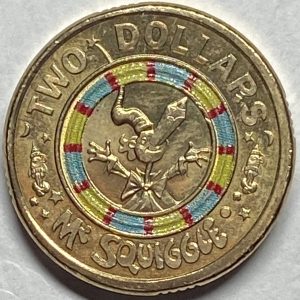
2019 Australia $2 Mr Squiggle
Pre-decimal Australian & UK coins, banknotes and world coins Circulated. The 2019 Australia $2 Mr Squiggle Commemorative coin features the 4th portrait of Queen Elizabeth
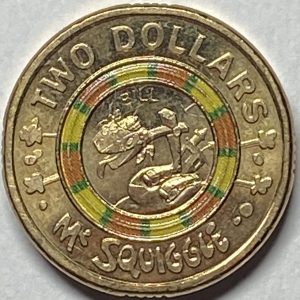
2019 Australia $2 Mr Squiggle ‘Bill’
Pre-decimal Australian & UK coins, banknotes and world coins Circulated. The 2019 Australia $2 Mr Squiggle Commemorative issue coin features the 4th portrait of Queen Elizabeth
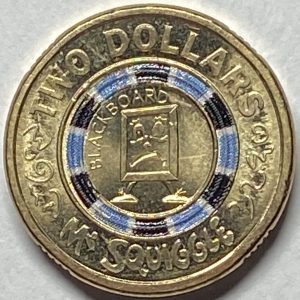
2019 Australia $2 Mr Squiggle ‘Blackboard’
Pre-decimal Australian & UK coins, banknotes and world coins Circulated. The 2019 Australia $2 Mr Squiggle ‘Blackboard’ commemorative issue features the 4th portrait of Queen
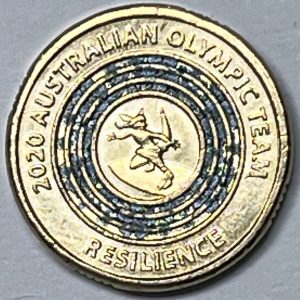
2020 AUSTRALIA $2 OLYMPIC TEAM
Pre-decimal Australian & UK coins, banknotes and world coins Circulated. Limited edition coloured coin for the 2020 Tokyo Olympic Games. Highlighting the attributes of the

